
HINTON, W.Va. — The tale of Mary Draper Ingles—of her escape from Shawnee captors and her return through the mountains—is the ideal American frontier story in many senses. It's a tale of endurance and indomitable spirit. And, because her adventures led through the valley of the New River, it has a unique appeal to residents of the Virginias.
As it's often recounted, the story has everything—bloodthirsty warriors, trackless nights in a forest, and a cannibalistic villain, a "Mad Dutchwoman," who pursues Ingles during her escape. Part of her route now runs through America's newest national park, the New River Gorge National Park and Preserve.
Only two sources of information about the matter exist
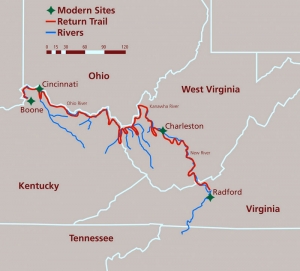
The problem is that we don't know much about the story at all. That's because only two primary sources for the tale exist, and both vary in the telling. Legends built around the root narrative may need to be trimmed away, and the motives of chroniclers who have handed down the tale may be in question.
The tale goes something like this: In the summer of 1755, a war party of Shawnee descends on an isolated settlement in Virginia, Draper's Meadows. They kill several settlers, including children. However, Mary Ingles and two sons were among a handful of captives led through the mountains to a village on the Ohio River.
After several months, Ingles escapes with another captive, "the Mad Dutchwoman," and the two make their way through mountain forests, including the treacherous New River Gorge, pursued by animals and hostile natives and loss. According to some sources, the Dutch woman attempts to eat Mary, who escapes and travels home alone to be reunited with her husband. According to others, she gives birth along the way.
"But there's a lot we don't understand," says Doug Wood, a historian and expert on native life during the settlement.
"For instance, we can't be certain about the birth of a child along the way. Some scholars question whether such a thing happened. One of the two primary sources mentions a baby; one does not."
Ingles was one of many frontier women who were captured
According to Karen Vuranch, who portrays Ingles and other heroines in living-history performances, the tale touches on the lives of countless other women who escaped Indian captors.
"One thing I stress about Mary is that she was only one of many women captured on the frontier, and she was only one of many who returned," Vuranch said.
"It's important to keep in mind that this happened often, but we know more about Mary because she came from a well-to-do family that fought in Washington's army, and so her tale was recorded."
Her tale also provided critical expert intelligence that England needed to battle the Shawnee and their allies during the French and Indian War.
Ingles was disdained by other frontier women after the event

Perhaps the best-known champion of clarity of context is Ellen Apperson Brown, whose work "What Really Happened at Drapers Meadows? The Evolution of a Frontier Legend" examines the challenges to the tale.
"In the first place, we need to be sure to understand the context of what life was like on the frontier. Mary suffered before the journey and afterward because of the culture," Brown said.
Though now regarded as a hero, Ingles was treated less-than-favorably by neighbors who did not look kindly on her adventures after her return.
Brown says readers must also consider the social context on a larger scale and consider the interplay of English, German, Scots-Irish, and Native American cultures.
The English were enjoying their first taste of capitalism. Freed of class constraints, they were hungry for land, she said.
The Scotch-Irish brought with them aggression fueled by years of war and upheaval. The Germans sought principally to live peaceful agrarian lives.
Natives, meanwhile, fought to defeat the onslaught of European culture while their own cultures had been infected by warring French and English interests that fought for control of the Ohio Valley.
The conflict between the English, the Scotch-Irish "long knives," and native groups led to heinous bloodshed, notably in incidents such as the Draper attack, from which Mary barely escaped.
On the morning that the Shawnee descended on the settlement, they killed several children outright and scalped other victims, many of whom died miserably of infection or blood loss.
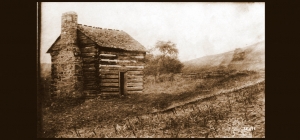
Colonel Patton, of the Scotch-Irish long-knives, particularly roused Shawnee ire, and his appearance at the settlement may have drawn the attack there, according to Brown.
"Why was Colonel Patton at Draper's Meadows in the first place?" she asks. 'We may never know, though I speculate his presence drew the Shawnee."
Brown says that discrepancies between the two principal narratives have helped create confusion, as have later embellishments. Parts of the two documents cited here reveal as much about its authors as the event.
Here is a portion of Mary's son's manuscript published in 1830:
"There had been severale parteys of the northern Indians, to wit, the Shawneys passed by where my Grandfather lived on their way to the Whites at that time however that hapey state of things did not last long the Indians found out that they [manuscript faulty] gratify their Hethan thirst for bloodshed and plunder much nearer Home and at length commenced a warfair on the frontier settlements & at a time it was little expected a partey of Shawneys fell in upon my fathers family and an uncles family John Draper which lived at the same place and killed severale and took the balance prisoners, to wit, my mother and her two children Thos, four yrs & George 2 & Aunt Draper & others. My grandmother Draper being a widow at that time & livin with my father was killed by [manuscript faulty] Col. Patton who was there who had a large claim of land in [blot on manuscript] waters was killed, also, & some other persons not recollected. My mother and her two shildren, Thos, the older 4 years old, and George abot 2 years old was taken as prisoners also My Aunt Draper who was wounded in her arm and Broke by a Ball which was shot at her in attempting to escape and severale others it so happened they made the attack on their harvest day and although there were severale men at the place the Indians took the advantage of attacking the Hows while the men [manuscript faulty] at their work in the harvest field and the field being some distance [manuscript faulty] the howse new nothing of the attack until it was Intirely out of Their power to render any survice to the family.
"My father when Hearing the alarm run up very near to the howse thinking perhaps he might render some service in some way although entirely unarmed the Indians discovering him two stout active Indians took after him with their tomehocks expecting to outrun him and kills him with their tomehocks & was very near affecting their purpose & nothing but a providential act saved him while the Indians wer pursuing him & gaining on him very fast one on each sid at some distance running throughthe woods where it was a little thick with brush & undergrowth, fortunately in jumping over a log fell. The Indians being so eager in persuit over run him my father on rising amediately Tacked back the other way and buy that means made his escape as there was no chance for what white men was there to render any releaf to the prisoners."
Brown compares Ingles's story with that of Letitia Preston Floyd, author of the second primary source, who describes the attack as part of a larger narrative covering events in the life of her father, William Preston:
"…on the 8th July 1755 it being a Sunday a party of Indians came up the Kanawha, thence to Sinking Creek, thence to Strouble’s Creek – Inglis & Draper, brothers in law, were living at Solitude, the present seat of Col. Robert T. Preston. The Indians came to Barger’s (1/2 mile nearer the Mountain) & cut his head off & put it in a bag; Barger was a very old man then came to Inglis’ and Drapers, and killed old Mrs. Draper, two children of Col. Inglis’, by knocking their brains out on the ends of the Cabin logs – took Mrs. Inglis and her sister-in-law Mrs. Draper Jr., who was trying to make her escape with her infant in her arms, but she was shot at by the Indians, who broke her arms by which means the infant was dropped – the Indians picked the infant up, & knocked its brains out agains the Cabin logs – Col. Patton that morning having dressed himself in his uniform, and getting his nephew William Preston to sew up in the fob of his small clothes thirty British guineas, told him to go to Sinking Creek to get Lybrook to help take off the harvest; which was then ready to cut; Preston went very early – After breakfast, Col. Patton sat down to write, the Indian war whoop was heard and five or six of them surrounded the cabin to set in on fore – The Col. Always kept his sword on his writing table – he rushed to the door with it in hand and encountered the Indians – Patton was almost gigantic in size – he cut two of the Indians down – in the mean while another warrior had leveled his gun and fired and killed the brave old pioneer – After Patton fell the Indians ran out in the thicket and made their escape before any pursuers could be brought."
Floyd then describes the birth of Mary's child, of which Ingles says nothing.
"In three months after her captivity Mrs. Inglis gave birth to a daughter; her sister-in-law had been traded off to another tribe of Indians as was her son. Three months after the birth of her child Mrs. Inglis determined to run away from the Indians, who were dreadfully cruel to her; another impulse was her great desire to see her husband, which made her undertake ajourney unparalleled in the incidents of a Pioneer’s life. She and a Dutch woman, who was taken from the upper part of Ohio, determined to escape together from the Indian towns; Mrs. Inglis left her child asleep in a bark cradle, although she was aware that according to Indian character the child would be killed as soon as its mother was missed.
"A series of remarkable events occurred to them on the route – Mrs.Inglis keeping up on the water Courses, when she got to the Ohio river, she and the Dutch woman tied logs together with grape vines, thus making a raft on which the two crossed the Ohio river; they were frequently near famishing with hunger, living on blackberries, sassafras leaves, frogs, etc., and in one instance eating a snake they found dead and a raccoon they found in a state of decomposition – All means failing a proposition was made that they should cast lost [lots] to see which should be eater by the other; the lot fell upon Mrs. Ingles; who understanding her travelling companion’s temper, promised her a sum of money to refrain from killing her; Col. Inglis was a very rich man & this proposition had the desired effect – Mrs. Inglis stepped off, leaving the Dutch woman to find her way as best she could – after many weekstravelling Mrs. Inglis arrived at Inglis ferry on New River the residence of Col. Inglis – She was afterwards the mother of a highly respectable family, who have always been distinguished for bravery and honesty – her grand children live on the place which she made such efforts to return to."
Brown says differences in the tales should lead us to consider the context of each.
"Notice that Letitia introduces several controversial topics," Brown says.
Floyd claims Mary and the Dutch woman drew straws to see which would eat the other and asserts that Mary abandoned her baby, knowing it would be killed. These details add to the drama but tend to portray Mary in a less-than-flattering way.
"Many 'respectable women' reading this account in the nineteenth century would probably have found Mary’s decision, not to mention her courage and independence, somewhat disturbing," Brown says.
"What sort of woman would decide to abandon her baby and attempt such a long journey – with no map, no provisions, and very little hope of success? How could anyone be so desperate as to draw straws to see which person would eat the other? Notice, too, that Mary offered a bribe to avoid being eaten."
Perhaps there was a long-standing rivalry between the two families, Brown writes, "for Letitia seems to describe Mary as a notorious character rather than someone to admire."
We may never know more than we know today of Ingles' adventures, Brown says, though she hopes the Internet and genealogical platforms can provide more context for the period.
As for the truth of the tale, she says she often refers to the story fashioned by James Alexander Thom in "Follow the River," a romantic fiction that nevertheless delves deep into context, especially where the motives of Native Americans are concerned.
"The novel is required reading for West Virginia students, and I think it provides a very good overview of the tale and its place in the history of the American frontier."
Legend of Van Bibber's Leap still echos in Kanawha Valley

The arrival of spring in what would become West Virginia in the late 1700s was not met with the enthusiasm with which we might greet it today, for fair weather also increased the potential for attack by native tribes. While the Iroquois and Cherokee had ceded their claim to the region west of the Alleghenies, the Shawnee had not, and their braves were raiding European settlements whenever the opportunity arose. Read the full story here.
Sign up to receive a FREE copy of West Virginia Explorer Magazine in your email weekly. Sign me up!










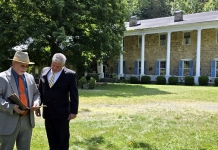


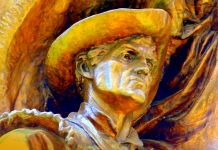

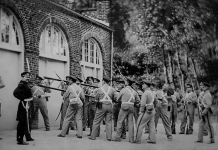

















Facebook Comments